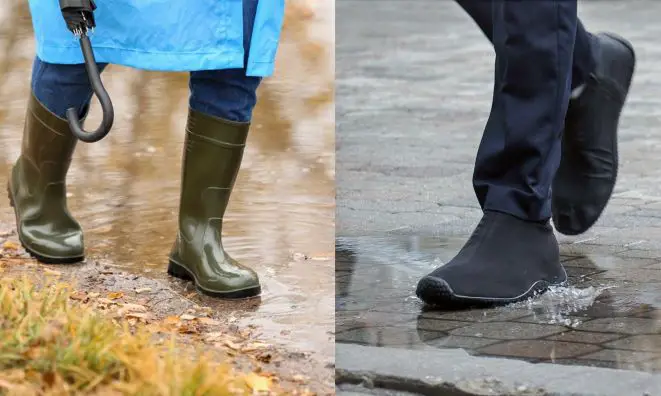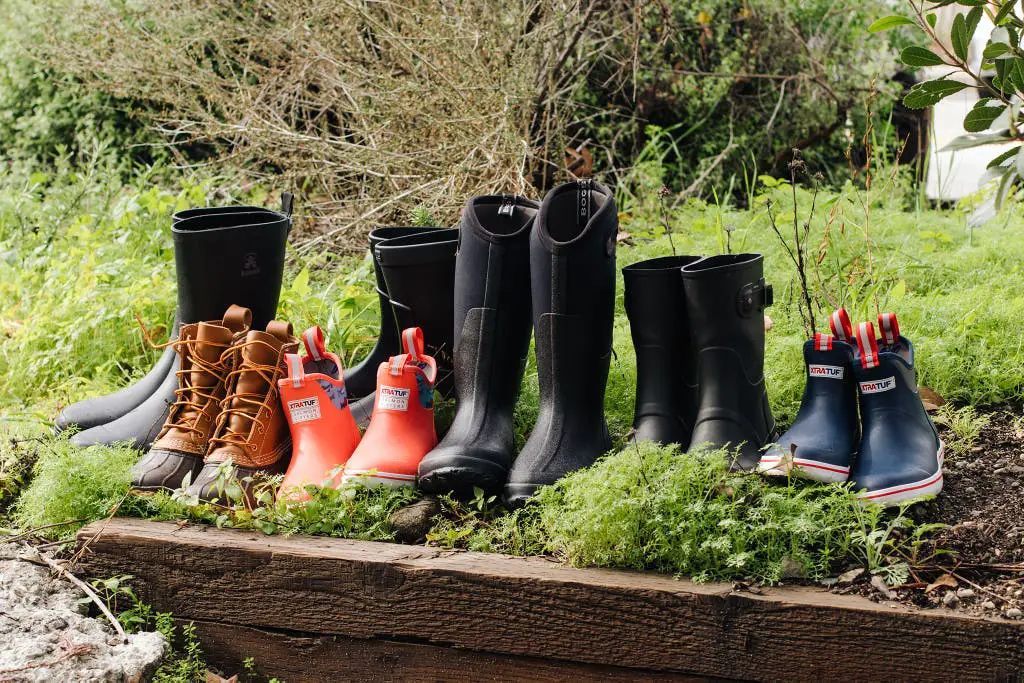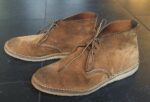There can be quite a lot of confusion when it comes to rain boots and galoshes with many people asking quite often if they are the same thing. No, they are not.
Rainboots are precisely boots that protect the lower leg and feet in rainy weather or wet environments.
Galoshes are a British term and protect shoes, as they are “over boots” that cover your daily footwear from rain, snow, and generally wet conditions.

If you have to move about in the rain or snow, both grime and salt can damage your shoes, and it doesn’t matter if they are dress shoes, work boots, or sneakers, they can still be damaged.
Dress shoes or appropriate footwear for the office can really take a hit in bad weather. So, the solution to this risk is to wear a pair of rain boots and carry your shoes or leave a change of shoes at the office.
You can also choose galoshes to protect whatever shoe you wear on a given day and then roll them up and slip them into your purse or briefcase. A lot will depend on your style.
Boots and Galoshes are not the same things. One takes the place of shoes when battling the elements while the other allows you to wear your preferred footwear and covers it to protect your shoes from the elements.
Both of these types of footwear are useful and would be useful as a part of your wardrobe. Much will depend on your area’s weather on any given day and how long you will be outdoors.
The Goods on Galoshes
Galoshes are basically a shoe covering, so they are ideal for people who move around a lot, in and out of offices, locations, and inclement weather.
If you are a lawyer who runs between the law firm and the courthouse, galoshes may be just what you need as you can slip them on and off of your footwear with relative ease, and your shoes will maintain a clean and professional appearance.
This can be an important consideration to factor in if you are not going to be spending all day outside in the elements. Because even a few blocks walk in rainy weather can do a number on your shoes.
If you move a lot for work, carrying shoes in a briefcase and wearing rain boots can prove to be quite inconvenient. Slipping on galoshes makes better sense. Galoshes are a great but temporary solution to a temporary difficulty.
Why Opt for Rainboots?
If your work or activities, have you spending most of the day outdoors in inclement weather, rain boots will probably be a better solution. If you work most of the time outside, you’ll be navigating puddles, and risk getting drenched, so more leg protection can come in handy.
Rain boots will eliminate the risk of getting feet or shoes wet, and if it happens to be winter, you can avoid exposing footwear to salt and oily grime on roads and sidewalks.
If you are spending a significant part of your day outdoors, rain boots will probably be the more appropriate choice, especially in nasty weather.
Can Rainboots Be Worn Over Shoes?
While this may not be their normal use, rain boots that will fit over shoes can be purchased. They are not the same as galoshes technically because they will most likely be full-sized boots that cover both the shoes and a good portion of your legs.
What’s the Difference Between Rain Boots and Galoshes?
The distinguishing characteristic between galoshes and rain boots will be how much of the legs and ankles they cover.
Galoshes will generally be more or less the size of your shoes and not noticeably larger. Galoshes are also not designed to protect the trousers, socks, or ankles.
Footwear that reaches and protects the calves of your legs are classified as rain boots. Galoshes will just cover shoes.
Which style you select in the end, will depend on your needs when out and about in nasty weather.
Rain Boot Styles and Materials

Rain boots are designed and produced to be worn in the elements, so you’ll find all kinds of styles, with and without laces, in multiple materials that are resistant to the elements and impervious to water. They will be produced in a selection of materials including
-
-
- Rubber
- Synthetic rubber
- Neoprene
-
and more. Because they are made of these waterproof materials, they require no type of treatment or extra waterproofing.
An exception to this will be if you choose to use hiking or work boots as rain boots. These will most likely require waterproofing especially if produced in leather.
Rain boots are made with mud, grime, and oils in mind. They are made to get dirty and are easy to keep clean. They offer the advantage of knowing that you don’t have to worry about where you step because you are protected, so enjoy those puddles.
Galoshes Materials and Style
The word “galoshes” originates from the French galoches and may be referred to as Dickersons, boat shoes, gumshoes, rubbers, or overshoes.
They are generally produced in rubber and are slipped over the pair of shoes you are wearing to protect them from mud, salt, and water.
While galoshes are frequently referred to interchangeably with “boots”, they are not boots and are to be considered an overshoe. They are produced to be weatherproof and protect a more delicate or vulnerable shoe underneath as well as keep feet dry and warm.
Traditional styles of galoshes were made from liquid or sheet rubber. Galoshes designs originally limited their use to a simple shoe cover and decidedly not for all-day wear. They were relatively thin and foldable so that they fit in a purse or briefcase.
Modern-day options now include galoshes with rubber outsoles and nylon or microfabric uppers that have been treated and styles may include fasteners to keep water from entering the wearer’s legs.
Manufacturing Methods
Rubber rain boots and galoshes are generally manufactured using one of several processes:
1.) Made from Rubber Sheets
Prepared rubber sheets will be unrolled and cut into pieces that are fitted on aluminum forms to mimic the design of the boot or galosh. The forms are then heated to form the rubber in the shape of the form and meld the parts together.
2.) Slush Molded
Galoshes and some shorter rain boots will be made with this method. A slightly larger metal mold is created. A last is created that fits within and liquid polyurethane or synthetic will be poured between the two forms.
The boot molds are spun to spread the liquid evenly. The mold will subsequently be removed, and any trimming and decorating completed.
3,) Fabric and Rubber
Outsoles are produced in sturdy vulcanized rubber with impressive tread designs. Uppers will be laser cut from microfabrics with computer guidance.
These may be lined with thermal insulation. The outer fabric is waterproofed, and then uppers are sewn onto outer soles.
| Rain Boots | Galoshes | |
| Upper boots | Rubber, synthetic, neoprene | Synthetics, micro fabrics, nylon |
| Soles | Rubber, synthetic rubber | Rubber, synthetic rubber |
| Waterproofing | Yes | Yes |
| Construction | Sheet rubber, molded | Molded, fabric with rubber |
| Style | Full boot that reaches the calf of the leg | Overshoe or short boot designed primarily for shoe protection |
Which Is Better? Rainboots or Galoshes
Ideally, both types of footwear have a place in the wardrobe of anyone who lives in a rainy zone. If choosing one or the other is a priority, it will come down to how you use them.
If you need them for a brief distance to protect shoes and desire protective footwear that is extremely portable, the galoshes are probably a better solution.
If on the other hand, you spend a lot of time outdoors in inclement weather, rain boots will prove to be more protective.
Both rain boots and galoshes are made using similar materials and processes, so you will find quality footwear in whichever style you eventually select.







